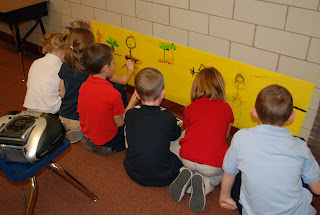We are on week 3 of rounding. Yes, you read that right. Week 3. Now some may wonder how such an easy concept could possibly take three weeks. I've been wondering that myself. But stuck we are, with the kids knowing the rules of rounding ("If it's 5 or more, raise the score; if it's 4 or less, let it rest"), but having no understanding of the actual concept. They don't know why you "raise the score" if it's 5 or more. They're not sure why digits in front of the rounding place end up staying the same. And they don't know why you would use rounding. Here are some things we've learned about rounding in the past three weeks.
1. Rounding is not changing a number, but finding a nearby number to use instead.

2. Rounding can be shown on a numberline
3. That 5 in "5 or more" isn't really a five (it's 500, or 5,000 or 50,000), and it shows the half-way point on a numberline

4. Before the half-way point, you're always closer to the lower number on the numberline
5. After the half-way point, you're always closter to the higher number on the numberline
6. Rounding means you have to understand place value and amounts!
Teaching rounding in a way they'll truly understand the concept has meant work with place value and number amounts. To help the kids, we did thousands charts...like a hundreds chart, but with bigger numbers!
Questions to ask with the charts:
* Write the number 100 in the first box. Write the number 200 in the second box. What do you think you should put in the third box?
* Fill in the rest of the first column. What number goes in the last box of that first row? (1,000) What would come next?
* What would come second in the second row? What would be third? Fill out the rest of the second row.
* Do you think you can fill out the third row on your own? Check with a partner when you're done.
* What patterns do you notice?
* Go to the top of the fourth column, that starts with the number 400. Read down the column together. What do you notice? What would come next if you continued the pattern?
* Does the same work with the seventh column? Go to the top of the seventh column, that starts with the number 700. Read down the column together. What would come next if you continued the pattern?
* Does the same work with the last column, starting with 1,000? What would come next in the column?
* Put your finger on the number 200. Put another finger on the number right below 200. How do you get from one row to the row below? (add 1,000) Why? Does that work with every row?
* Can you fill out the next two rows on your own?
* What do you think will be the last number on the entire chart?
* Find the number 3,700 and shade it red. What number would be 1,000 more? Shade it blue. What would be 1,000 less? Shade it blue. What number would be 100 more? Shade it blue. What number would be 100 less? Shade it blue.
* Go back to the target (red) number. What would be 900 more? How can you figure it out without counting forward 9 squares? (Find 1,000 more, do 1 less) What would be 900 less? How could you figure it out quickly?
* Fill out the rest of the chart. Were you right about your prediction of the last number on the chart?
Get the charts and worksheets!














































